
- Publisher: University of Hawaii Press
- Available in: Hardcover
- ISBN: 978-0824867805
- Published: March 31, 2017
Theravada Traditions offers a unique comparative approach to understanding Buddhism: it examines popular rituals of central importance in the predominantly Theravada Buddhist cultures of Laos, Sri Lanka, Thailand, Myanmar, and Cambodia. Instead of focusing on how religious ideas have impacted the ideals of government or ethical practice, author John Holt tries to ascertain how important changes, or shifts, in the trajectories of the political economies of societies have impacted the character of religious cultures.
Each of the five chapters focuses on a particular rite and provides detailed historical, political, or social context: Holt shows how worship of the Phra Bang Buddha image in the annual pi mai or New Year’s rites in Luang Phrabang, Laos, has changed dramatically since the 1975 communist revolution and the subsequent opening up of the country to tourism; he describes how, in the face of insurrections and a prolonged civil war, the annual asala perahara processions in Kandy, Sri Lanka, have come to reflect a robust assertion of a Sinhala Buddhist nationalist identity; how ordination rites among Thai Buddhists reflect the manner in which Thai culture has been ever more “commodified” in the context of its dramatically developing economy; and how in tightly controlled Myanmar the kathina rite, the act of giving new robes to members of the sangha after the completion of the rain-retreat season, transformed into a season of campaigning for gift-giving and merit-making; finally, he demonstrates how, in light of the devastating losses inflicted by the Khmer Rouge, pchum ben, the annual rite of caring ritually for one’s deceased kin, became the most popular and perhaps most emotionally observed of all rites in the Khmer calendar year.
In short, Theravada Traditions illustrates how popular, public ritual performance, far from being static, clearly indexes patterns of social and political change. Broad but deep, rigorous yet accessible, this rich, innovative volume provides a provocative introduction to the practice of Theravada Buddhism and the nature of social change in contemporary Sri Lanka and Southeast Asia.
Reviews
A masterful and original approach to the study of Theravada Buddhism. By focusing on five distinct Buddhist rituals in five different countries, John Holt succeeds in presenting the “performance” of Theravada traditions in both their unity and diversity. In featuring present day practices set against their historical and sociocultural backdrops, the author effectively combines his insights as a historian of religion and buddhologist with his expertise as a seasoned interviewer and observer of Buddhism-on-the-ground. Fluidly written, and solidly researched, this book will both interest scholars and serve students as a substantive introduction to the field.–John S. Strong, author of Buddhisms: An Introduction
It is rare to have a book that is not only clear, accessible, and broad, but also rigorous, detailed, and highly respectful of context. It is an impressive achievement that not only provides the most up-to-date research on major questions about the very nature of the term Theravada and various approaches to ritual, but also gives five close studies of rituals in five different national contexts. The writer’s skill as a teacher and the benefit of a keen eye, long-term experience, and sound disciplinary training make this book a resounding success.–Justin Thomas McDaniel, author of Architects of Buddhist Leisure: Socially Disengaged Buddhism in Asia’s Museums, Monuments, and Amusement Parks
This rich and informative book on the ritual cultures of Theravada Buddhism shows how rituals, far from being static, evolve subtly in ways that reflect social, economic, and political changes. By drawing together examples from across the Theravada world and providing a full exploration and interpretation of each, we have in a single volume both a major study of Theravada and the elucidation of the many functions of ritual through dynamic, living examples.
–Kate Crosby, author of Theravada Buddhism: Continuity, Diversity, and Identity